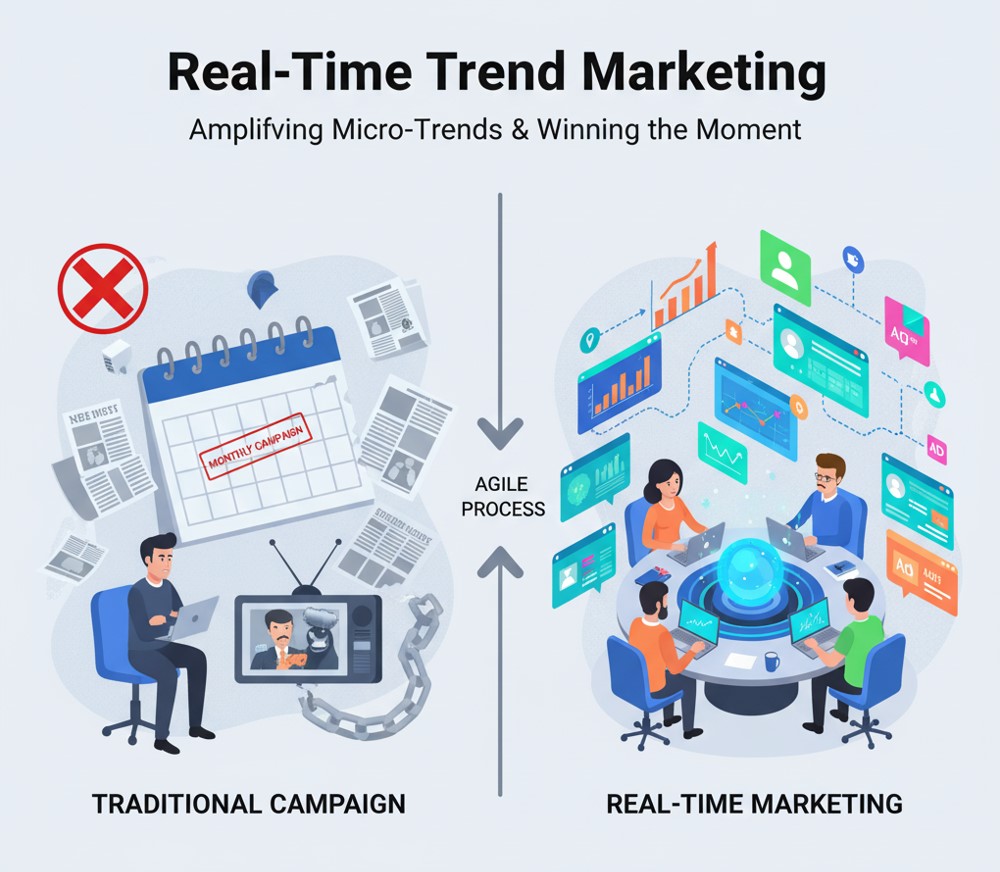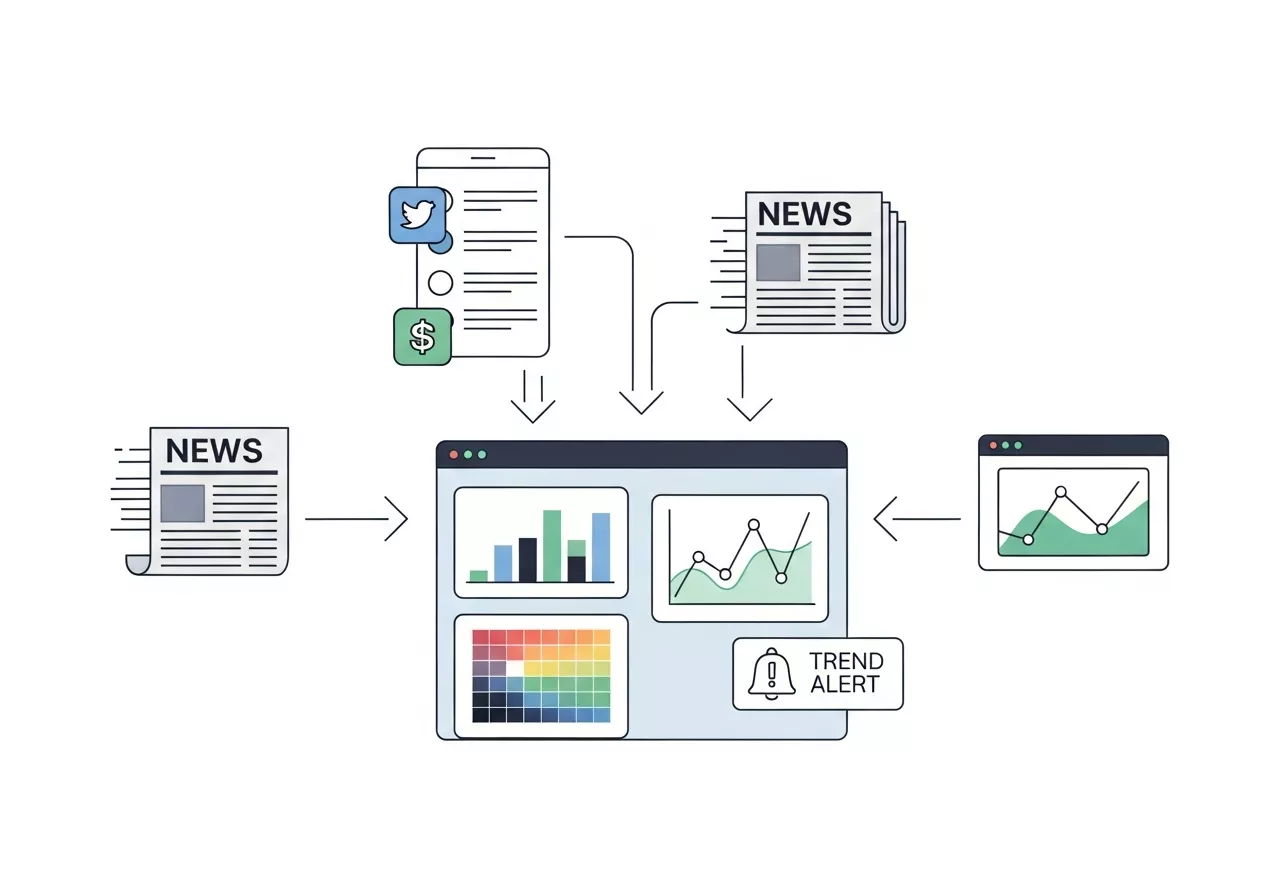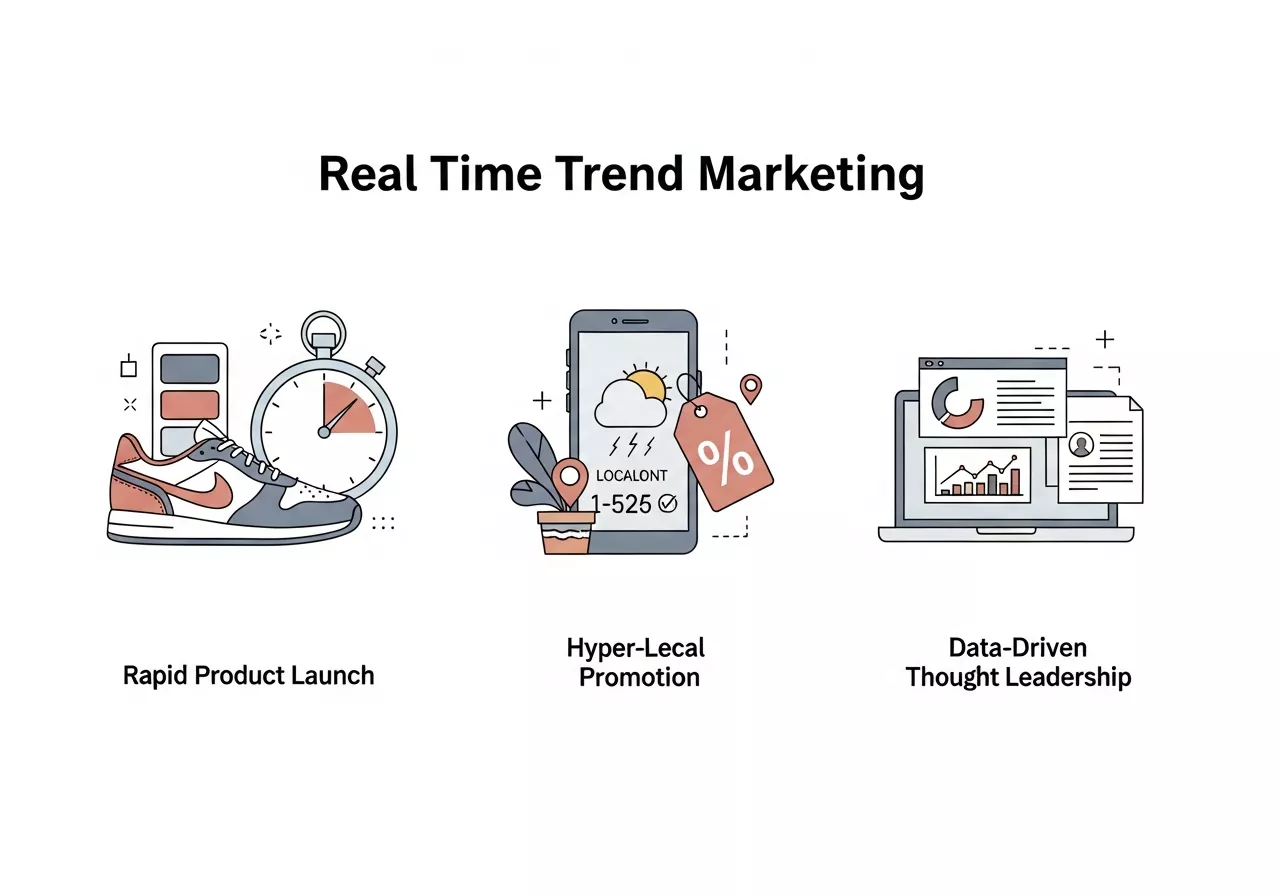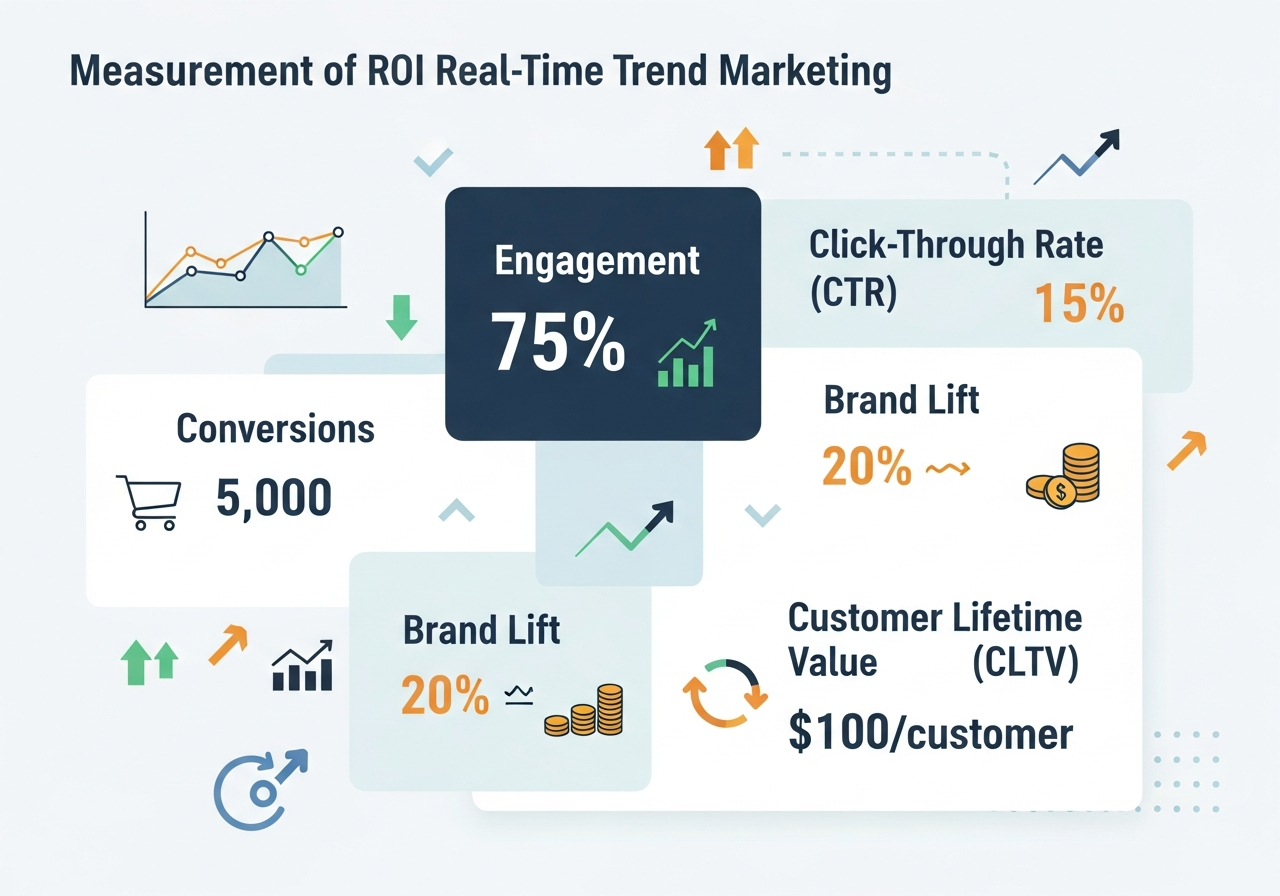
Real-time trend marketing enables brands to capitalize on micro-moments by monitoring emerging trends, leveraging data and agile content, collaborating with influencers, and measuring impact. Timely, relevant, and brand-aligned campaigns drive engagement, conversions, and sustained audience loyalty.
In today’s fast-paced digital environment, consumers expect relevant content precisely when and where they need it. Real-time trend marketing combines data-driven insights, social listening, and dynamic content delivery to meet these heightened expectations. By leveraging micro-moments—those brief instances when people turn to their devices seeking answers—brands can capture attention and drive meaningful action. This strategy empowers marketers to pivot campaigns on the fly, inserting brands into evolving conversations about trending topics. Throughout this guide, you’ll discover actionable steps for collecting real-time data, choosing the right tools, implementing micro-moment tactics, and measuring performance for sustained growth. Whether you’re a seasoned marketing professional or an entrepreneur exploring trend-driven opportunities, this post offers a comprehensive roadmap for transforming fleeting consumer behaviors into lasting brand loyalty.
As trends emerge and fade in the blink of an eye, the ability to react swiftly becomes a critical competitive advantage. Brands that master real-time trend marketing often outpace competitors who rely on outdated, rigid content calendars. In the following sections, we will break down the core components of this approach, explore essential technology stacks, share best practices, and highlight real-world examples of brands that successfully harness the power of immediacy. By the end of this post, you will be equipped to craft a real-time trend marketing playbook tailored to your unique industry and audience.
1. Understanding Real-Time Trend Marketing

Real-time trend marketing refers to the practice of monitoring emerging topics, cultural conversations, and consumer behaviors across digital channels as they unfold. Rather than building strictly long-term campaigns that risk being outdated by the time they launch, brands adopt agile processes that allow rapid response to the latest buzz. This approach relies on social listening, competitor analysis, and direct feedback loops to identify potential viral triggers. When marketers detect a relevant trend—be it a viral hashtag, breaking news, or a cultural moment—they swiftly develop tailored content that resonates with the audience’s current mindset. Critical to this strategy is having predefined brand guidelines and approval workflows that maintain consistency under tight deadlines. In essence, real-time trend marketing bridges the gap between consumer expectations for immediacy and a brand’s need for coherent messaging, positioning brands as authentic participants in the conversation rather than passive observers.
Key benefits include heightened engagement rates, increased shareability, and the ability to capitalize on peak consumer interest windows. However, without careful planning, brands risk appearing opportunistic or off-brand. Balance agility with strategy by establishing clear decision-making protocols and creative templates that speed up production. In the next section, we’ll delve into micro-moments, the most granular unit of real-time engagement that offers unparalleled targeting precision.
2. The Power of Micro-Moments
Coined by Google, “micro-moments” describe the intent-rich moments when consumers turn to their devices to act on a need to learn, do, discover, watch, or buy something. These are intent-driven touchpoints—often lasting mere seconds—that collectively shape modern purchasing journeys. By aligning marketing efforts with these micro-moments, brands can deliver highly relevant, helpful content exactly when consumers are most receptive. For example, a fitness apparel brand might serve quick workout tip videos when users search “5-minute abs workout,” or a travel service could highlight last-minute flight deals when someone looks up “weekend getaway near me.” Such contextually targeted interactions not only boost conversion rates but also foster brand affinity by providing timely value. Integrating micro-moment strategies into a real-time trend marketing framework enables marketers to move beyond broad demographics to tap into specific consumer needs at the precise moment of engagement.
To maximize impact, identify your brand’s most common micro-moments using analytics data and search insights. Map these moments across the customer journey, then tailor your content mix—videos, infographics, quick tips, or AI-driven chat widgets—to address each need. As you’ll see later, brands that excel at micro-moments view their content ecosystem as a dynamic toolkit rather than a static library.
3. Leveraging Real-Time Data and Analytics

The backbone of any successful real-time trend marketing initiative is a robust data infrastructure. Social listening platforms like Brandwatch or Sprout Social gather millions of data points from forums, social media, and news sources to spot emerging keywords, sentiment shifts, and competitive movements. Complement these insights with web analytics data—Google Analytics, heatmap tools, and real-time dashboards—to understand on-site behavior and identify content gaps. API integrations between these tools enable centralized tracking of key metrics such as engagement spikes, click-through rates, and bounce rates during trending events. By synthesizing these data streams, marketers can make informed decisions in real time, deciding which trends warrant investment and which deserve a quick pass.
Building a cross-functional analytics team that includes data engineers, business analysts, and content strategists ensures that insights translate quickly into action. Establish clear performance benchmarks for each trend-driven campaign, and leverage A/B testing to optimize messaging variations on the fly. With a solid data backbone, your real-time trend marketing initiatives will be grounded in evidence rather than intuition, reducing risk and maximizing ROI.
4. Essential Tools and Platforms
Real-time trend marketing demands a tech stack that supports rapid ideation, production, and distribution. Key categories of tools include social listening (e.g., Mention, Talkwalker), content creation suites with automated templating (e.g., Canva Pro, Adobe Express), and collaboration platforms (e.g., Asana, Monday.com) that keep distributed teams in sync. For video and visual content, consider leveraging AI-driven editors like Lumen5 or Wibbitz to generate short-form assets in minutes. Chatbots and conversational AI—powered by platforms such as Drift or Intercom—can engage users in micro-moments, answer queries, and collect behavioral data around the clock. Additionally, social media schedulers with real-time publishing capabilities, like Hootsuite or Buffer, ensure your trend-responsive content goes live at optimal times across channels.
Investing in a unified dashboard, built on tools like Tableau or Looker, provides centralized visibility into all ongoing campaigns, enabling rapid pivots based on performance data. The right combination of these tools empowers your marketing team to monitor, create, and execute trend-driven content at the speed consumers expect, without compromising on brand quality or coherence.
5. Crafting Agile Content for Trend Relevance
Agile content production underpins successful real-time trend marketing. Begin by developing a flexible content library composed of modular assets—templates for social media posts, blog headers, infographics, and short-form video clips. Establish a rapid approval workflow that balances brand guidelines with speed, allowing creative teams to iterate on trending themes without lengthy sign-offs. When a new trend emerges, leverage these modular components to create on-brand, relevant content within hours rather than days. Infuse your messaging with an authentic brand voice, and ensure compliance with legal or regulatory requirements by embedding guardrails into your creative briefs.
Encourage cross-functional collaboration between copywriters, designers, and data analysts through daily stand-up meetings focused solely on trend monitoring. Document recurring themes and successful content formats in a shared knowledge base to reduce duplication of effort over time. By adopting an agile mindset, your marketing department will be primed to ride the crest of every relevant trend, delivering timely content that resonates deeply with target audiences.
6. Case Studies of Success in Real-Time Trend Marketing

Several brands have raised the bar for real-time trend marketing through creative, data-driven campaigns. For instance, a global sportswear company used live social listening during a major tournament to design limited-edition sneakers within 48 hours, complete with fan-selected color schemes. The rapid-release strategy drove a 35 percent spike in e-commerce sales and garnered extensive media coverage. Another example involves a food delivery service that monitored geo-specific weather data and pushed targeted discounts on rainy days, resulting in a 20 percent lift in app downloads during monsoon seasons. Finally, a B2B software provider leveraged LinkedIn analytics to publish whitepapers addressing trending pain points in enterprise cybersecurity, leading to a 50 percent increase in qualified leads over a single quarter.
These case studies demonstrate the diverse applications of real-time trend marketing, from product innovation to hyper-local promotions and thought leadership. Regardless of your industry, the underlying principles—speed, data-driven decision-making, and contextual relevance—remain the same.
7. Overcoming Common Challenges
While real-time trend marketing offers compelling advantages, it also presents unique challenges. Rapid execution can lead to misaligned messaging if brand guidelines are unclear or if teams lack sufficient training on trending subjects. Resource constraints—particularly in smaller organizations—may limit the ability to staff around-the-clock monitoring and content production. Data noise poses another risk: not every spike in social chatter translates to genuine consumer interest, and failing to distinguish between superficial trends and meaningful opportunities can waste budget. Moreover, some trending topics carry reputational risks if brands misjudge the cultural context or inadvertently offend audiences.
To navigate these pitfalls, invest in ongoing team training on brand values and cultural sensitivity. Implement rigorous trend qualification criteria—such as volume thresholds, sentiment analysis scores, and alignment with strategic objectives—to filter out false positives. Finally, build contingency plans that allow you to pull content quickly if a trend turns controversial, safeguarding brand reputation while maintaining agility.
8. Measuring ROI and Optimizing Campaigns

Measuring return on investment for real-time trend marketing requires a blend of short-term and long-term KPIs. Immediate metrics include engagement rates, click-through rates, and conversions tied directly to trend-driven campaigns. However, tracking downstream effects—such as brand lift studies, customer lifetime value, and repeat purchase rates—is equally important for understanding sustained impact. Utilize UTM-coded URLs, custom landing pages, and attribution models that capture the full customer journey. By correlating performance data with campaign timelines, marketers can pinpoint which trends delivered tangible returns and allocate budget accordingly in future cycles.
Continuous optimization hinges on iterative testing. Analyze campaign data weekly to identify high-performing content formats, channels, and trend categories. Scale successful tactics, retire underperformers, and refine your real-time marketing playbook. Over time, this data-driven approach transforms real-time trend marketing from a reactive tactic into a proactive growth engine aligned with overarching business objectives.
Conclusion
Real-time trend marketing represents a paradigm shift from static, long-term campaigns to an agile, data-driven approach that resonates with consumers in the moment. By combining real-time data, micro-moment strategies, and modular content production, brands can capture fleeting opportunities, drive engagement, and propel sustainable growth. A successful trend marketing strategy depends on a robust tech stack, clear brand guidelines, and a culture of experimentation. Although challenges such as resource constraints and data noise must be managed, the potential rewards—heightened brand relevance, increased conversion rates, and elevated customer loyalty—justify the investment. As digital ecosystems continue to evolve, mastering real-time trend marketing will empower your brand to stay one step ahead, turning every micro-moment into a strategic advantage. Embrace the tools and best practices shared in this guide to create a responsive marketing engine that thrives on momentum.
Frequently Asked Questions (FAQ) – Real-Time Trend Marketing
1. What is real-time trend marketing?
Real-time trend marketing is the practice of monitoring emerging topics, cultural conversations, and consumer behaviors as they happen, then quickly creating and distributing relevant content. This approach allows brands to engage audiences during micro-moments—those brief, intent-driven touchpoints—rather than relying on long-term, static campaigns.
2. What are micro-moments, and why are they important?
Micro-moments are short instances when consumers turn to their devices with a specific intent: to learn, do, discover, watch, or buy something. They are critical because brands that provide timely, relevant content during these moments can influence purchasing decisions, boost engagement, and build brand loyalty.
3. Which tools are essential for real-time trend marketing?
Key tools include:
- Social listening: Brandwatch, Sprout Social, Talkwalker
- Content creation: Canva Pro, Adobe Express, Lumen5, Wibbitz
- Collaboration & workflow: Asana, Monday.com
- Conversational AI: Drift, Intercom
- Social scheduling & publishing: Hootsuite, Buffer
- Analytics dashboards: Tableau, Looker
These tools enable monitoring, rapid content production, and centralized decision-making.
4. How can brands create content quickly without compromising quality?
- Develop a modular content library with templates for posts, videos, and graphics.
- Implement a rapid approval workflow with clear brand guidelines.
- Foster cross-functional collaboration between content, design, and analytics teams.
- Document successful content formats in a shared knowledge base for future reuse.
This agile approach ensures fast, relevant, and on-brand content creation.
5. How do I measure the success of real-time trend campaigns?
- Immediate metrics: Engagement rates, click-through rates, conversions tied to trends
- Long-term metrics: Brand lift, customer lifetime value, repeat purchase rates
- Attribution methods: UTM-coded URLs, custom landing pages, multi-touch attribution
Analyzing both short-term spikes and downstream impact ensures accurate ROI measurement.
6. What are common challenges in real-time trend marketing?
- Misaligned messaging due to unclear brand guidelines
- Resource constraints limiting monitoring and content production
- Data noise: distinguishing genuine trends from fleeting spikes
- Reputational risk if cultural context is misjudged
Mitigation: Training teams on brand values, applying trend qualification criteria, and creating contingency plans for quick content removal.
7. How do I know which trends are worth acting on?
Evaluate trends using criteria such as:
- Relevance to brand values
- Volume and velocity of engagement
- Potential ROI and engagement lift
- Execution feasibility
Trends that align strategically, have significant reach, and can be executed quickly are typically high-value opportunities.
8. Can small businesses benefit from real-time trend marketing?
Yes! Small businesses can leverage niche trends, micro-influencers, and agile workflows to compete with larger brands. Using modular content, automated tools, and focused monitoring, small teams can capture micro-moments efficiently without a massive budget.
9. How can data and analytics improve trend marketing performance?
Real-time data enables:
- Spotting emerging trends before competitors
- Measuring engagement and sentiment instantly
- Optimizing content formats, channels, and messaging on the fly
- Making evidence-based decisions instead of relying on intuition
A cross-functional analytics team ensures insights translate into actionable campaigns.
10. What’s the most important factor for successful real-time trend marketing?
Speed, relevance, and brand alignment. Brands must act quickly on trends, deliver contextually valuable content, and ensure every message aligns with their identity and values. This combination drives engagement while maintaining credibility and trust.
Learn more about: Mastering Micro-Trend Marketing: How Real-Time Insights Propel Brand Growth










Leave a Reply